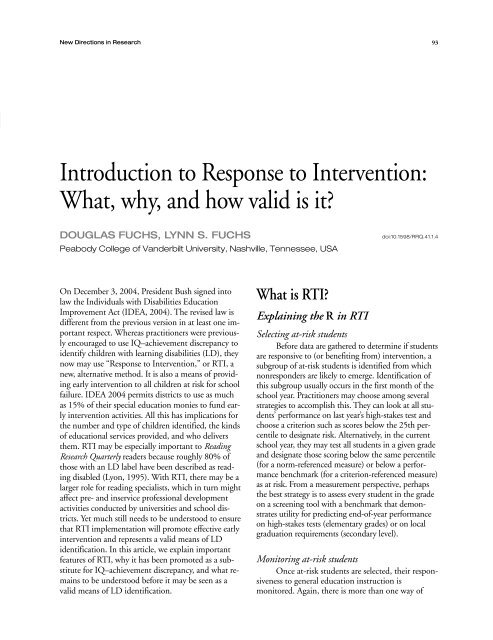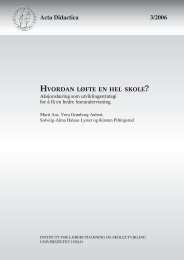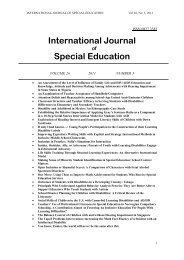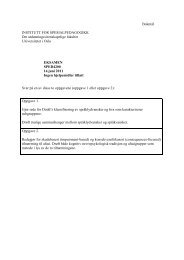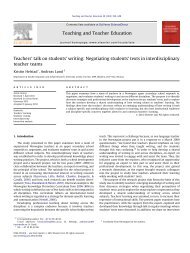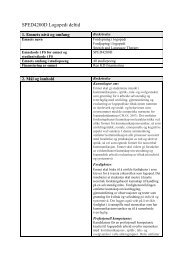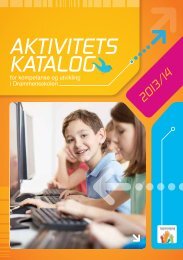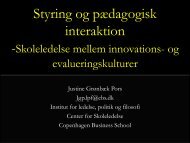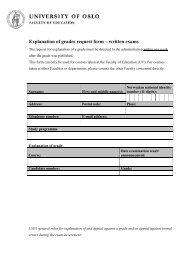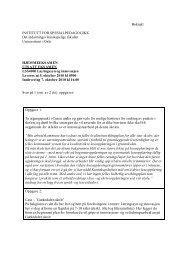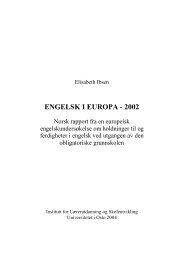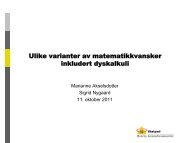Introduction to Response to Intervention: What, why, and how valid ...
Introduction to Response to Intervention: What, why, and how valid ...
Introduction to Response to Intervention: What, why, and how valid ...
You also want an ePaper? Increase the reach of your titles
YUMPU automatically turns print PDFs into web optimized ePapers that Google loves.
New Directions in Research 93<strong>Introduction</strong> <strong>to</strong> <strong>Response</strong> <strong>to</strong> <strong>Intervention</strong>:<strong>What</strong>, <strong>why</strong>, <strong>and</strong> <strong>how</strong> <strong>valid</strong> is it?DOUGLAS FUCHS, LYNN S. FUCHSPeabody College of V<strong>and</strong>erbilt University, Nashville, Tennessee, USAdoi:10.1598/RRQ.41.1.4On December 3, 2004, President Bush signed in<strong>to</strong>law the Individuals with Disabilities EducationImprovement Act (IDEA, 2004). The revised law isdifferent from the previous version in at least one importantrespect. Whereas practitioners were previouslyencouraged <strong>to</strong> use IQ–achievement discrepancy <strong>to</strong>identify children with learning disabilities (LD), theynow may use “<strong>Response</strong> <strong>to</strong> <strong>Intervention</strong>,” or RTI, anew, alternative method. It is also a means of providingearly intervention <strong>to</strong> all children at risk for schoolfailure. IDEA 2004 permits districts <strong>to</strong> use as muchas 15% of their special education monies <strong>to</strong> fund earlyintervention activities. All this has implications forthe number <strong>and</strong> type of children identified, the kindsof educational services provided, <strong>and</strong> who deliversthem. RTI may be especially important <strong>to</strong> ReadingResearch Quarterly readers because roughly 80% ofthose with an LD label have been described as readingdisabled (Lyon, 1995). With RTI, there may be alarger role for reading specialists, which in turn mightaffect pre- <strong>and</strong> inservice professional developmentactivities conducted by universities <strong>and</strong> school districts.Yet much still needs <strong>to</strong> be unders<strong>to</strong>od <strong>to</strong> ensurethat RTI implementation will promote effective earlyintervention <strong>and</strong> represents a <strong>valid</strong> means of LDidentification. In this article, we explain importantfeatures of RTI, <strong>why</strong> it has been promoted as a substitutefor IQ–achievement discrepancy, <strong>and</strong> what remains<strong>to</strong> be unders<strong>to</strong>od before it may be seen as a<strong>valid</strong> means of LD identification.<strong>What</strong> is RTI?Explaining the R in RTISelecting at-risk studentsBefore data are gathered <strong>to</strong> determine if studentsare responsive <strong>to</strong> (or benefiting from) intervention, asubgroup of at-risk students is identified from whichnonresponders are likely <strong>to</strong> emerge. Identification ofthis subgroup usually occurs in the first month of theschool year. Practitioners may choose among severalstrategies <strong>to</strong> accomplish this. They can look at all students’performance on last year’s high-stakes test <strong>and</strong>choose a criterion such as scores below the 25th percentile<strong>to</strong> designate risk. Alternatively, in the currentschool year, they may test all students in a given grade<strong>and</strong> designate those scoring below the same percentile(for a norm-referenced measure) or below a performancebenchmark (for a criterion-referenced measure)as at risk. From a measurement perspective, perhapsthe best strategy is <strong>to</strong> assess every student in the gradeon a screening <strong>to</strong>ol with a benchmark that demonstratesutility for predicting end-of-year performanceon high-stakes tests (elementary grades) or on localgraduation requirements (secondary level).Moni<strong>to</strong>ring at-risk studentsOnce at-risk students are selected, their responsiveness<strong>to</strong> general education instruction ismoni<strong>to</strong>red. Again, there is more than one way of
94 Reading Research Quarterly JANUARY/FEBRUARY/MARCH 2006 41/1doing this. At the end of a relatively short period(e.g., eight weeks) of classroom instruction, at-riskstudents may be administered a brief st<strong>and</strong>ardizedachievement test in the area of risk. Responsivenessmay be defined as “a score above the 16th percentile.”An arguably better method would requirepractitioners <strong>to</strong> compare the at-risk students’ performance<strong>to</strong> (a) local or national normative estimatesfor weekly improvement or (b) criterion-referencedfigures for weekly improvement. If (a) <strong>and</strong> (b) areunavailable, then responsiveness may be operationalizedas “some improvement” (i.e., increased achievementgreater than the st<strong>and</strong>ard error of estimate).At-risk children unresponsive <strong>to</strong> classroom instructionare given more intensive instruction at a secondtier, or level, either in or outside the classroom, asdiscussed subsequently in this article. And their performanceduring this more intensive, second-tier instructionmay be assessed in a manner similar <strong>to</strong> <strong>how</strong>performance was assessed during first-tier instructionprovided <strong>to</strong> all students.Much of RTI assessment, therefore, is progressmoni<strong>to</strong>ring. It is a form of dynamic assessment becauseits metric is change in students’ level or rate oflearning. Such information assists practitioners’ effortsboth <strong>to</strong> design early intervention <strong>and</strong> <strong>to</strong> identifyspecial-needs children. Regarding earlyintervention, progress moni<strong>to</strong>ring can be unders<strong>to</strong>odin part as formative evaluation: Teachers use the data<strong>to</strong> determine whether they need <strong>to</strong> change their curricula,materials, or instructional procedures.Progress moni<strong>to</strong>ring also generates diagnostic informationthat helps practitioners make classification<strong>and</strong> program placement decisions (e.g., moving astudent from tier 1 <strong>to</strong> tier 2).Explaining the I in RTIFocus on reading instructionMost educa<strong>to</strong>rs look <strong>to</strong> RTI as a means of deliveringearly intervention <strong>to</strong> address academic problems,not school behavior problems. Specifically, theinterventions typically target reading problems <strong>and</strong>,more specifically, early reading problems (e.g., AlOtaiba & Fuchs, in press; McMaster, Fuchs, Fuchs,& Comp<strong>to</strong>n, 2005; O’Connor, 2000; Vaughn,Linan-Thompson, & Hickman, 2003; Vellutino etal., 1996). This is not accidental. Many of the samepolicymakers behind RTI were also responsible forReading First, a major component of No Child LeftBehind (2002), which requires schools <strong>to</strong> use scientificknowledge <strong>to</strong> guide selection of core curricula<strong>and</strong> <strong>to</strong> use <strong>valid</strong> screening measures <strong>and</strong> progressmoni<strong>to</strong>ring <strong>to</strong> identify students in need of more intensiveinstruction. In a sense, RTI may be unders<strong>to</strong>odas an important aspect of Reading First <strong>and</strong>current educational policy.Multitiered instructionRTI is also multitiered. Different RTI versionshave two <strong>to</strong> four tiers of instruction (see Fuchs,Mock, Morgan, & Young, 2003). The nature of theacademic intervention changes at each tier, becomingmore intensive as a student moves across thetiers. Increasing intensity is achieved by (a) usingmore teacher-centered, systematic, <strong>and</strong> explicit (e.g.,scripted) instruction; (b) conducting it more frequently;(c) adding <strong>to</strong> its duration; (d) creatingsmaller <strong>and</strong> more homogenous student groupings; or(e) relying on instruc<strong>to</strong>rs with greater expertise.Some practitioners (e.g., Grimes, 2002) regard thesetiers as substituting for the comprehensive evaluationnow afforded all children suspected of having LD.Others (e.g., Division of Learning Disabilities of theCouncil for Exceptional Children, n.d.; Telzrow,McNamara, & Hollinger, 2000) see the RTI tiers asa component of a more comprehensive <strong>and</strong> traditionalevaluation. The first group views RTI mostlyin terms of providing prevention <strong>and</strong> advocates formore tiers. The second group regards RTI mostly asan identification <strong>and</strong> classification procedure <strong>and</strong> arguesfor fewer tiers.Problem solvingTo date, practitioners conducting RTI use aproblem-solving approach <strong>to</strong> intervention.Researchers, by contrast, favor the use of st<strong>and</strong>ardtreatment pro<strong>to</strong>cols. To explain problem solving, weturn <strong>to</strong> the work of practitioners in the Heartl<strong>and</strong>(Iowa) Educational Agency. As part of statewide reform,Heartl<strong>and</strong> staff developed a four-level problem-solvingmodel partly <strong>to</strong> “provide educationalassistance in a timely manner” (Grimes, 2002, p. 8).According <strong>to</strong> Ikeda <strong>and</strong> Gustafson (2002), at Level1, a teacher confers with a student’s parent(s) <strong>to</strong> try<strong>to</strong> resolve academic or behavior problems. At Level2, a teacher <strong>and</strong> his or her school’s BuildingAssistance Team meet <strong>to</strong> identify <strong>and</strong> analyze problems<strong>and</strong> <strong>to</strong> help the teacher select, implement, <strong>and</strong>moni<strong>to</strong>r the effectiveness of an intervention. An absenceof success at this level triggers the involvemen<strong>to</strong>f Heartl<strong>and</strong> staff, which defines Level 3. Heartl<strong>and</strong>staff is mostly doc<strong>to</strong>ral- or master’s-level school psychologists<strong>and</strong> special educa<strong>to</strong>rs who use behavioralproblem solving <strong>to</strong> refine or redesign the interven-
New Directions in Research 95tion <strong>and</strong> coordinate its implementation. Finally, atLevel 4, special education assistance <strong>and</strong> due processprotections are considered.At each problem-solving level, the process ismeant <strong>to</strong> be the same: Practitioners determine themagnitude of the problem, analyze its causes, designa goal-directed intervention, conduct it as planned,moni<strong>to</strong>r student progress, modify the intervention asneeded (i.e., based on student responsiveness), <strong>and</strong>evaluate its effectiveness <strong>and</strong> plot future actions (cf.Grimes, 2002). Throughout this problem-solvingprocess, <strong>and</strong> across the four tiers, “data about a student’sresponsiveness <strong>to</strong> intervention becomes thedriving force” (Grimes, p. 4). Teachers <strong>and</strong>Heartl<strong>and</strong> staff are directed <strong>to</strong> compare a student’sperformance level <strong>and</strong> learning rate with what is expectedof other students in the same classroom. It isthe student’s relative classroom performance, ratherthan test performance, that determines responsiveness<strong>and</strong> eventually special education eligibility.The problem-solving approach <strong>to</strong> interventionhas been adopted by a significant number of schooldistricts (A. Canter, personal communication,February 4, 2003), including the Minneapolis PublicSchools (see Mars<strong>to</strong>n, Muyskens, Lau, & Canter,2003). Its popularity among practitioners is nodoubt due in part <strong>to</strong> its idiopathic nature: For eachchild, an effort is made <strong>to</strong> personalize assessment <strong>and</strong>intervention. But this individualized approach is apotential weakness as well as a strength. The problem-solvingapproach presupposes considerable expertiseamong practitioners in assessment <strong>and</strong>intervention. They must be skillful in numeroustypes of assessment <strong>and</strong> intervention; they must havethe clinical judgment <strong>and</strong> experience <strong>to</strong> know whichassessments <strong>and</strong> interventions <strong>to</strong> apply; <strong>and</strong> theymust have the knowledge, discipline, <strong>and</strong> opportunity<strong>to</strong> accurately measure the effectiveness of interventions,which are sometimes a unique hybrid of twoor more evidence-based practices that in combinationhave no track record (see Fuchs et al., 2003, fora review of the evidence on the problem-solving approach).St<strong>and</strong>ard treatment pro<strong>to</strong>colA st<strong>and</strong>ard treatment pro<strong>to</strong>col is an alternative<strong>to</strong> problem solving. Whereas the problem-solving approachdiffers from child <strong>to</strong> child, a st<strong>and</strong>ard treatmentpro<strong>to</strong>col does not. Implementation usuallyinvolves a trial of fixed duration (e.g., 10 <strong>to</strong> 15weeks) delivered in small groups or individually (e.g.,Al Otaiba & Fuchs, in press; McMaster et al., 2005;Vaughn et al., 2003; Vellutino et al., 1996). If studentsrespond <strong>to</strong> the treatment trial, they are seen asremediated <strong>and</strong> disability-free <strong>and</strong> are returned <strong>to</strong> theclassroom for instruction. If they are unresponsive,they move <strong>to</strong> a more intensive, Tier 2 st<strong>and</strong>ard treatmentpro<strong>to</strong>col. If they then demonstrate adequateprogress, they are returned <strong>to</strong> the classroom. But ifthey s<strong>how</strong> insufficient progress at Tier 2, a disability issuspected <strong>and</strong> further evaluation is warranted.This approach is illustrated by the work ofVellutino <strong>and</strong> colleagues (e.g., Vellutino et al., 1996),who asked first-grade teachers <strong>to</strong> nominate theirpoorest readers at the beginning of the school year.At the start of the second semester, Vellutino et al. assignedthe children <strong>to</strong> tu<strong>to</strong>ring <strong>and</strong> contrast groups.The tu<strong>to</strong>red children received a 30-minute, one-<strong>to</strong>oneintervention five days each week for most of thesemester. This intervention amounted <strong>to</strong> between 70<strong>and</strong> 80 tu<strong>to</strong>ring sessions, which focused on phonemicawareness, decoding, sight-word practice, comprehensionstrategies, <strong>and</strong> reading connected text. Inthe fall of second grade, tu<strong>to</strong>red students below the40th percentile on the Basic Skills Cluster participatedin another eight <strong>to</strong> ten weeks of tu<strong>to</strong>ring.Two thirds of the tu<strong>to</strong>red students demonstrated“good growth” or “very good growth” after one semesterof first-grade tu<strong>to</strong>ring. Indeed, they hadbasically caught up <strong>to</strong> their classmates. Vellutino etal. (1996) suggested that these students had not reallybeen reading disabled but “instructionally” disabled.By contrast, the remaining one third of thetu<strong>to</strong>red readers remained in the lowest 30th percentileon the Word Identification <strong>and</strong> Word Attacksubtests of the Woodcock Reading MasteryTest–Revised (WRMT–R), despite receiving tu<strong>to</strong>ringin both first <strong>and</strong> second grade. The researchersdescribed these children as “difficult <strong>to</strong> remediate.”<strong>Intervention</strong>-as-testAs with assessment, intervention—be it problemsolving or a st<strong>and</strong>ard treatment pro<strong>to</strong>col—servesRTI’s two purposes: <strong>to</strong> provide struggling studentswith early, effective instruction <strong>and</strong> <strong>to</strong> provide a <strong>valid</strong>means of assessing learner needs. The I in RTI has,in a sense, become the test stimulus. Children’s levelor rate of growth—their degree of responsiveness—isthe test performance. Although many RTI proponentsare critical of the traditional psychometric approach,they still must prove the <strong>valid</strong>ity of theirmethods; in this case, intervention-as-test. A principalmeans of demonstrating the <strong>valid</strong>ity ofintervention-as-test is by using evidence-based interventions<strong>and</strong> by ensuring that, in each instance, theyare implemented with fidelity. In this regard, the
96 Reading Research Quarterly JANUARY/FEBRUARY/MARCH 2006 41/1st<strong>and</strong>ard treatment pro<strong>to</strong>col may have a leg up onproblem solving. Everyone knows what <strong>to</strong> implementbecause there is but one pro<strong>to</strong>col, which makestraining easier <strong>to</strong> accomplish <strong>and</strong> fidelity of implementationeasier <strong>to</strong> assess <strong>and</strong> ensure; in turn, thismakes it more likely that it can be “scaled up” in adistrict or school building. As best we know, <strong>how</strong>ever,the comparative fidelity of implementation (<strong>and</strong>effectiveness) of the two approaches has not been exploredwithin the same experimental design. Suchexploration represents an important <strong>and</strong> promisingarea of research.Why RTI?Special education costsFor decades, policymakers <strong>and</strong> academics havebeen frustrated by the LD construct generally <strong>and</strong> byIQ–achievement discrepancy particularly. One prominentreason is economics. In a sense, LD became <strong>to</strong>osuccessful for its own good—if success may be definedby the number of children with the label. Shortly afterLD was legitimized as a special-education category inthe Education of All H<strong>and</strong>icapped Children Act of1975, the proportion of children with LD in the generalU.S. population skyrocketed from less than 2% in1976–1977 <strong>to</strong> more than 6% in 1999–2000. This increasehas proved expensive for school districts because,on average, it costs two <strong>to</strong> three times more <strong>to</strong>teach children with disabilities. Not long ago, NewYork City was spending US$1.67 billion, or 22 centsof every school dollar, on special education (Dillon,1994) <strong>to</strong> provide services <strong>to</strong> 130,037 students or 13%of the city’s one million school children (NationalAssociation of State Boards of Education, 1991).IQ–achievement discrepancyIQ–achievement discrepancy, which is themost widely used method of LD identification, hasoften been viewed as the culprit with respect <strong>to</strong> risingspecial education enrollments <strong>and</strong> costs, which bringsus <strong>to</strong> a second reason for dissatisfaction with the LDconstruct. The discrepancy approach has been frequentlycriticized as atheoretical (e.g., Lyon, 1987;Willson, 1987) <strong>and</strong>, according <strong>to</strong> some, this absenceof theory has permitted states <strong>and</strong> districts <strong>to</strong> specifydiscrepancy differently. Today, discrepancy varies nationwidein terms of (a) <strong>how</strong> it is computed (e.g.,st<strong>and</strong>ard IQ score minus st<strong>and</strong>ard achievement scoreversus the regression of IQ on achievement), (b) itssize (e.g., 1.0 SD versus 2.0 SDs), <strong>and</strong> (c) which IQ<strong>and</strong> achievement tests are used. Not surprisingly,these varying definitional features <strong>and</strong> criteria haveled <strong>to</strong> large inconsistencies in LD prevalence betweenstates <strong>and</strong> sometimes between districts within states(e.g., Reschly & Hosp, 2004; Scruggs & Mastropieri,2002).Such inconsistency in the definition ofIQ–achievement discrepancy <strong>and</strong> varying prevalencerates—as well as the outright noncompliance bysome school-level personnel with state <strong>and</strong> districtguidelines (cf. Gottlieb, Alter, Gottlieb, & Wishner,1994)—have contributed <strong>to</strong> a widespread view thatthe LD designation is whatever teachers <strong>and</strong> parentswant it <strong>to</strong> be (e.g., Coles, 1987). A more damagingassertion, perhaps, is that the IQ–achievement discrepancyapproach fails <strong>to</strong> distinguish a qualitativelydifferent <strong>and</strong> more deserving subgroup of studentsfrom a much larger group of low achievers. Studiessuggest that young, poor readers with <strong>and</strong> without anIQ–achievement discrepancy perform similarly onmany reading-related cognitive tasks (e.g., Fletcher etal., 1994; Foorman, Francis, & Fletcher, 1995;Stanovich & Siegel, 1994), as well as demonstratephonological processing deficits that are correctablewith appropriate instruction (e.g., Fletcher, 1995;Morris et al., 1998; Stanovich, 1999; Torgesen,Morgan, & Davis, 1992; Vellutino et al., 1996).Thus, say critics, thanks <strong>to</strong> the IQ–achievementdiscrepancy approach, the LD label is not just arbitrarilyassigned, it is unfairly withheld from childrenwho are as needy <strong>and</strong> deserving as those given thelabel. Many who advocate on behalf of RTI may viewit as a means of reallocating resources—away fromdiscrepant, middle class children of dubious disability<strong>to</strong> nondiscrepant, low-socioeconomic-status, lowachievingstudents who, prior <strong>to</strong> IDEA reauthorization,often fell between the cracks of service-deliverysystems.Concerns that IQ–achievement discrepancy isatheoretical <strong>and</strong> arbitrary, <strong>and</strong> that some of its basicassumptions have not been supported by research,have crystallized for many in<strong>to</strong> two major criticisms.First, it represents a wait-<strong>to</strong>-fail model antithetical <strong>to</strong>early intervention; that is, children must fall dramaticallybehind their peers in academic achievement <strong>to</strong>qualify as LD. Second, critics say that the lowachievement of so-called children with LD is presumed<strong>to</strong> reflect disability when, more times thannot, it reflects poor teaching. Because RTI encouragesappropriate use of evidence-based instructionacross tiers, it should in principal decrease the numbersof children incorrectly identified as disabled.
New Directions in Research 97Unanswered questions,unresolved issuesProblem solving <strong>and</strong> st<strong>and</strong>ardtreatment pro<strong>to</strong>col: Conceptual issuesassociated with “nonresponsiveness”False negatives versus false positivesAs described in a previous section, problemsolving<strong>and</strong> st<strong>and</strong>ard treatment pro<strong>to</strong>col approachesdiffer operationally. They also differ conceptually,<strong>and</strong> each promotes a different implicit meaning of“nonresponsiveness.” The st<strong>and</strong>ard treatment pro<strong>to</strong>colmay be considered a relatively rigorous test fornonresponsiveness <strong>and</strong> disability. Nonresponders,like those in the Vellutino et al. (1996) study, participatedin evidence-based instruction delivered <strong>to</strong>small groups. The nonresponders’ lack of progress almostseemed <strong>to</strong> defy the systematicity <strong>and</strong> intensityof their educational experience <strong>and</strong> the expertise <strong>and</strong>effort of their instruc<strong>to</strong>rs. Their nonresponsivenessappears much more likely caused by disability than<strong>to</strong> the absence of good instruction. The st<strong>and</strong>ardtreatment pro<strong>to</strong>col seems <strong>to</strong> facilitate identificationof “true positives,” or children truly in need of special(e.g., individualized) services.At the same time, use of the st<strong>and</strong>ard treatmentpro<strong>to</strong>col approach raises this question: Is it possiblethat some children who are nonresponsive <strong>to</strong> Tier 1 instruction,but who become responsive in a second orthird tier, still have a disability <strong>and</strong>, once returned <strong>to</strong>their classroom for instruction (without the intensity<strong>and</strong> systematic instruction of the st<strong>and</strong>ard treatmentpro<strong>to</strong>col), will again demonstrate the same learningproblems that first marked them as c<strong>and</strong>idates for Tier2? That is, whereas the st<strong>and</strong>ard treatment pro<strong>to</strong>col approachis likely <strong>to</strong> identify true positives, it also appearslikely <strong>to</strong> identify false negatives, or children who inhigher tiers seem responsive <strong>and</strong> nondisabled but who,nevertheless, cannot survive in the mainstream classroom.The investigation by Vaughn et al. (2003) providesevidence in support of this possibility. A subset ofchildren who met criteria for dismissal from intensivetu<strong>to</strong>ring failed <strong>to</strong> perform adequately when they returned<strong>to</strong> their classrooms, <strong>and</strong> they eventually requiredadditional tu<strong>to</strong>ring.Problem solving, with its typically less intensive<strong>and</strong> less systematic instruction, seems less likely thanthe st<strong>and</strong>ard treatment pro<strong>to</strong>col approach <strong>to</strong> identifyfalse negatives <strong>and</strong> more likely <strong>to</strong> identify false positives,or children who appear nonresponsive <strong>and</strong> disabledbut, with more intensive instruction, c<strong>and</strong>emonstrate they are neither, which raises the followingquestion for practitioners <strong>and</strong> policymakers:Is it more desirable <strong>to</strong> err by identifying more falsenegatives (st<strong>and</strong>ard treatment pro<strong>to</strong>col) or by identifyingmore false positives (problem solving)?Who is in the normative population?Problem-solving <strong>and</strong> st<strong>and</strong>ard treatment pro<strong>to</strong>colapproaches also pose different technical challenges.As indicated, the different problem-solving tiers typicallyoccur in the classroom; st<strong>and</strong>ard treatment pro<strong>to</strong>colsare usually implemented outside the classroom insmall groups. Assessing responsiveness <strong>to</strong> instruction ina classroom context has the advantage of a normativeframework referenced <strong>to</strong> the larger population of typicalstudents in school. That is, responsiveness <strong>to</strong> generallyeffective classroom instruction can be estimated forall students so that a normative profile can be generated<strong>to</strong> describe the full range of responses. With classroominstruction as the intervention, traditional cutpoints (e.g., 1.5 st<strong>and</strong>ard deviations below the mean)may be used <strong>to</strong> define disability. Such an approach requiresmeasurement of all students. By contrast, itseems unlikely that a normative framework may be applied<strong>to</strong> the st<strong>and</strong>ard treatment pro<strong>to</strong>col approach.Logistics <strong>and</strong> logic seem <strong>to</strong> argue against exposing thefull range of students <strong>to</strong> an intensive tu<strong>to</strong>ring regimenfor the purpose of producing a normative profile. In alllikelihood, practitioners would need <strong>to</strong> rely on a normativeframework restricted <strong>to</strong> very poor readers, aproposition requiring empirical <strong>valid</strong>ation.Access <strong>to</strong> special educationIn comparison <strong>to</strong> the st<strong>and</strong>ard treatment pro<strong>to</strong>colapproach, problem solving usually represents alower bar in determining nonresponsiveness <strong>and</strong> access<strong>to</strong> special education. Assuming that special educationis effective, this helps ensure that all childrenwith special needs receive appropriate services. Yet,relatively easy access <strong>to</strong> special education can, insome cases, reflect a rush <strong>to</strong> judgment <strong>and</strong>, as explained,the identification of false positives, or childrenwho are incorrectly identified. In selectingbetween problem-solving <strong>and</strong> st<strong>and</strong>ard treatmentpro<strong>to</strong>col, it may be necessary <strong>to</strong> determine whetherone’s primary intent is identification or prevention.Measuring <strong>and</strong> definingnonresponsivenessRegardless of which RTI approach is adopted,two components of the assessment process must bespecified. First, a method must be conceptualized for
98 Reading Research Quarterly JANUARY/FEBRUARY/MARCH 2006 41/1measuring students’ responsiveness <strong>to</strong> instruction.Second, once student responsiveness has been conceptualized,a criterion must be applied for definingnonresponsiveness. Beneath such a criterion, studentsare identified as having reading disabilities.Various methods are available for specifyingthese two assessment components. As described in aprevious section, Vellutino et al. (1996) tested studentson WRMT–R several times over the course ofa multiyear study. To establish a cut point for responsiveness,Vellutino et al. rank-ordered slopesrepresenting children’s growth in responsiveness <strong>to</strong>tu<strong>to</strong>ring, performed a median split on the slopes,<strong>and</strong> designated the bot<strong>to</strong>m half as nonresponsive.Similarly, Torgesen <strong>and</strong> colleagues (2001) evaluatedstudent performance at the end of treatment on thesubtests of the WRMTs, designating nonresponsivenessas failing <strong>to</strong> achieve so-called normalized status;that is, a word-reading st<strong>and</strong>ard score of 90 or better.Good, Simmons, <strong>and</strong> Kame’enui (2001), likeTorgesen et al. (2001), also specified nonresponsivenessin terms of posttreatment status. However, theirapproach involves a criterion-referenced benchmarkassociated with future reading success.Speece <strong>and</strong> Case (2001) <strong>to</strong>ok yet a different tack.They adopted frequent student moni<strong>to</strong>ring usingcurriculum-based measures so that nonresponsivenesscould be identified earlier in the school year than ispossible with the Vellutino et al. (1996), Torgesen et al.(2001), or Good et al. (2001) methods. Speece <strong>and</strong>Case applied a “dual discrepancy” criterion (e.g., Fuchs& Fuchs, 1998; Fuchs, Fuchs, & Speece, 2002).Nonresponders were students whose slope <strong>and</strong> level ofperformance fell at least 1 st<strong>and</strong>ard deviation belowtheir class mean. (This dual-discrepancy approachcould also be determined with respect <strong>to</strong> school, district,or national norms or using benchmark cut pointsassociated with future reading performance.)These alternative methods produce differentprevalence rates of reading disability <strong>and</strong> different subsetsof nonresponsive children; that is, different childrenare identified by the different methods (seeFuchs, Fuchs, & Comp<strong>to</strong>n, 2004). This is importantbecause a major criticism of IQ–achievement discrepancyas a method of LD identification has been theunreliability of the diagnosis. Practitioners relying onan assortment of assessment procedures in an RTIframework may produce similarly unreliable diagnoses.So researchers must develop a common approach<strong>to</strong> define <strong>and</strong> assess nonresponsiveness. Furthercomplicating this task is that various assessment methodsdemonstrate differential utility in distinguishingresponsive <strong>and</strong> nonresponsive groups on differentcomponents of reading; that is, an assessment methodwith demonstrated <strong>valid</strong>ity for beginning decodingskills may be in<strong>valid</strong> for assessing reading comprehension(see Fuchs et al., 2004). For this reason, consistencyin identifying nonresponders across the variouscomponents of reading is an important criterion forselecting a <strong>valid</strong> approach <strong>to</strong> assessment.These unanswered questions <strong>and</strong> issues challengethose who would use an RTI framework <strong>to</strong> define disabilities.Nevertheless, we believe the framework hasstrong potential. Right now, we most clearly see itspromise in regards <strong>to</strong> <strong>how</strong> its multilayered structurecan be implemented in the early grades <strong>to</strong> strengthenthe intensity <strong>and</strong> effectiveness of reading instructionfor at-risk students, preventing chronic school failurethat corrodes children’s spirit <strong>and</strong> diminishes all of uswho work on behalf of the public schools.DOUGLAS FUCHS is Nicholas Hobbs Chair of Special Education <strong>and</strong>Human Development at V<strong>and</strong>erbilt University, where he codirects theV<strong>and</strong>erbilt-Kennedy Center Reading Clinic. His research focuses onissues of disability classification <strong>and</strong> reading instruction for strugglinglearners. He can be contacted at the Department of Special Education,Box 328 Peabody, V<strong>and</strong>erbilt University, Nashville, TN 37203, USA, orby e-mail at doug.fuchs@v<strong>and</strong>erbilt.edu.LYNN S. FUCHS is Nicholas Hobbs Professor of Special Education <strong>and</strong>Human Development at V<strong>and</strong>erbilt University. Her research focuses onthe connection between classroom assessment <strong>and</strong> teachers’instructional planning as well as reading <strong>and</strong> mathematics disability.She can be contacted at 328 Peabody, V<strong>and</strong>erbilt University, Nashville,TN 37203, USA, or by e-mail at lynn.fuchs@v<strong>and</strong>erbilt.edu.REFERENCESAL OTAIBA, S., & FUCHS, D. (in press). Who are the young childrenfor whom best practices in reading are ineffective? An experimental<strong>and</strong> longitudinal study. Journal of Learning Disabilities.COLES, G. (1987). The learning mystique: A critical look at learningdisabilities. New York: Pantheon.DILLON, D. (1994, August 14). New York City schools moni<strong>to</strong>r contendsthat special education cost is inflated. The New York Times, p. 18.DIVISION OF LEARNING DISABILITIES OF THE COUNCILFOR EXCEPTIONAL CHILDREN. (n.d.). <strong>Response</strong> <strong>to</strong> OSEP’s consensusstatement. Unpublished paper.EDUCATION OF ALL HANDICAPPED CHILDREN ACT OF1975, Pub. L. 94–142 (5.6)FLETCHER, J.M. (1995). Diagnostic utility of intelligence testing <strong>and</strong>the discrepancy model for children with learning disabilities: His<strong>to</strong>rical perspectives<strong>and</strong> current research. Paper presented at the IQ Testing <strong>and</strong>Educational Decision Making Workshop, National Research Council,National Academy of Sciences, Washing<strong>to</strong>n, D.C.FLETCHER, J.M., SHAYWITZ, S.E., SHANKWEILER, D.P.,KATZ, L., LIBERMAN, I.Y., STUEBING, K.K., FRANCIS, D.J., ETAL. (1994). Cognitive profiles of reading disability: Comparisons of discrepancy<strong>and</strong> low achievement definitions. Journal of EducationalPsychology, 86, 6–23.FOORMAN, B.R., FRANCIS, D.J., & FLETCHER, J.M. (1995).Growth of phonological processing skill in beginning reading: The lag versusdeficit model revisited. Paper presented at the Society for Research on ChildDevelopment. Indianapolis, IN.FUCHS, D., FUCHS, L.S., & COMPTON, D.L. (2004).Identifying reading disability by responsiveness-<strong>to</strong>-instruction: Specifyingmeasures <strong>and</strong> criteria. Learning Disability Quarterly, 27, 216–227.FUCHS, D., MOCK, D., MORGAN, P.L., & YOUNG, C.L.(2003). Responsiveness-<strong>to</strong>-intervention: Definitions, evidence, <strong>and</strong>
New Directions in Research 99implications for the learning disabilities construct. Learning DisabilitiesResearch & Practice, 18, 157–171.FUCHS, L.S., & FUCHS, D. (1998). Treatment <strong>valid</strong>ity: A unifyingconcept for reconceptualizing the identification of learning disabilities.Learning Disabilities Research & Practice, 13, 204–219.FUCHS, L.S., FUCHS, D., & SPEECE, D.L. (2002). Treatment<strong>valid</strong>ity as a unifying construct for identifying learning disabilities.Learning Disability Quarterly, 25, 33–46.GOOD, R.H., SIMMONS, D.C., & KAME’ENUI, E.J. (2001).The importance <strong>and</strong> decision-making utility of a continuum of fluencybasedindica<strong>to</strong>rs of foundational reading skills for third-grade high-stakesoutcomes. Scientific Studies of Reading, 5, 257–288.GOTTLIEB, J., ALTER, M., GOTTLIEB, B.W., & WISHNER,L. (1994). Special education in urban America: It’s not justifiable formany. Journal of Special Education, 27, 453–465.GRIMES, J. (2002). Responsiveness <strong>to</strong> interventions: The next step inspecial education identification, service <strong>and</strong> exiting decision making. Paperpresented at Office of Special Education Programs LD SummitConference, Washing<strong>to</strong>n, DC.IKEDA, M., & GUSTAFSON, J.K. (2002). Heartl<strong>and</strong> AEA 11’s problemsolving process: Impact on issues related <strong>to</strong> special education (Research Rep.No. 2002–01). Johns<strong>to</strong>n, IA: Heartl<strong>and</strong> Area Education Agency 11.INDIVIDUALS WITH DISABILITIES EDUCATIONIMPROVEMENT ACT OF 2004, Pub. L. 108–466.LYON, G.R. (1987). Severe discrepancy: Theoretical, psychometric,developmental, <strong>and</strong> educational issues. Learning Disabilities Research &Practice, 3, 10–11.LYON, G.R. (1995). Research initiatives in learning disabilities:Contributions from scientists supported by the National Institute of ChildHealth <strong>and</strong> Human Development. Journal of Child Neurology, 10 (suppl.1), S120–S126.MARSTON, D., MUYSKENS, P., LAU, M., & CANTER, A.(2003). Problem-solving model for decision making <strong>and</strong> high-incidencedisabilities: The Minneapolis experience. Learning Disabilities Research &Practice, 18, 187–200.MCMASTER, K.L., FUCHS, D., FUCHS, L.S., & COMPTON,D.L. (2005). Responding <strong>to</strong> nonresponders: An experimental field trial ofidentification <strong>and</strong> intervention methods. Exceptional Children, 71, 445–463.MORRIS, R.D., SHAYWITZ, S.E., SHANKWEILER, D.R, KATZ,L., STUEBING, K.K., FLETCHER, J.M., LYON, R.G., ET AL. (1998).Subtypes of reading disability: Variability around a phonological core.Journal of Educational Psychology, 90, 347–373.NATIONAL ASSOCIATION OF STATE BOARDS OF EDUCA-TION. (1991, Oc<strong>to</strong>ber). Special education: New questions in an era of reform.Alex<strong>and</strong>ria, VA: Author.NO CHILD LEFT BEHIND ACT OF 2001, Pub. L. No. 107-110,115 Stat. 1425 (2002).O’CONNOR, R.E. (2000). Increasing the intensity of interventionin kindergarten <strong>and</strong> first grade. Learning Disabilities Research & Practice,15, 43–54.RESCHLY, D.J., & HOSP, J.L. (2004). State SLD identificationpolicies <strong>and</strong> practices. Learning Disability Quarterly, 27, 197–213.SCRUGGS, T.E., & MASTROPIERI, M.A. (2002). On babies <strong>and</strong>bathwater: Addressing the problems of identification of learning disabilities.Learning Disability Quarterly, 25, 155–168.SPEECE, D.L., & CASE, L.P. (2001). Classification in context: Analternative approach <strong>to</strong> identifying early reading disability. Journal ofEducational Psychology, 93, 735–749.STANOVICH, K.E. (1999). The sociopsychometrics of learningdisabilities. Journal of Learning Disabilities, 32, 350–361.STANOVICH, K.E., & SIEGEL, L.S. (1994). Phenotypic performanceprofile of children with reading disabilities: A regression-basedtest of the phonological-core variable-difference model. Journal ofEducational Psychology, 86, 24–53.TELZROW, C.F, MCNAMARA, K., & HOLLINGER, C.L.(2000). Fidelity of problem-solving implementation <strong>and</strong> relationship <strong>to</strong>student performance. School Psychology Review, 29, 443–461.TORGESEN, J.K., ALEXANDER, A., WAGNER, R., RASHOTTE,C., VOELLER, K., & CONWAY, T. (2001). Intensive remedial instructionfor children with severe reading disabilities: Immediate <strong>and</strong> longtermoutcomes from two instructional approaches. Journal of LearningDisabilities, 34, 33–58.TORGESEN, J.K., MORGAN, S., & DAVIS, C. (1992). The effectsof two types of phonological awareness training on word learning inkindergarten children. Journal of Educational Psychology, 84, 364–370.VAUGHN, S., LINAN-THOMPSON, S., & HICKMAN, P.(2003). <strong>Response</strong> <strong>to</strong> instruction as a means of identifying students withreading/learning disabilities. Exceptional Children, 69, 391–409.VELLUTINO, F.R., SCANLON, D.M., SIPAY, E.R., SMALL, S.,CHEN, R., PRATT, A., & DENCKLA, M.B. (1996). Cognitive profilesof difficult-<strong>to</strong>-remediate <strong>and</strong> readily remediated poor readers: Earlyintervention as a vehicle for distinguishing between cognitive <strong>and</strong> experientialdeficits as basic causes of specific reading disability. Journal ofEducational Psychology, 88, 601–638.WILLSON, V.L. (1987). Statistical <strong>and</strong> psychometric issues surroundingsevere discrepancy. Learning Disabilities Research, 3(1), 24–28.
Reproduced with permission of the copyright owner. Further reproduction prohibited without permission.


